Information
Wei State Cemetery of Western Zhou Dynasty found in Yangjinzhuang, Henan Province
Summary: Wei State Cemetery of Western Zhou Dynasty found in Yangjinzhuang, Henan ProvinceFrom:Chinese ArchaeologyWriter:Date:2017-08-22Yangjinzhuang Cemetery was located in Gaocun Town Qi County, Henan Province. A rescue excavation has been made by the joint team
Wei State Cemetery of Western Zhou Dynasty found in Yangjinzhuang, Henan Province
From:Chinese Archaeology Writer: Date:2017-08-22
Yangjinzhuang Cemetery was located in Gaocun Town Qi County, Henan Province. A rescue excavation has been made by the joint team from Henan Provincial Institute of Cultural Relics and Archaeology and Qi County Administration of Heritage and Tourism from March to October 2016. The cemetery covers an area of 30,000 square meters, 190 meters east to west and 150 meters south to north. The excavation was carried out at the north part of the cemetery, in a total area of 5000 square meters, including 224 medium- and small-sized tombs, 5 horse buried pits and one house remain. Nearly 400 burial objects were unearthed. The burials were dated to the Western Zhou Dynasty.
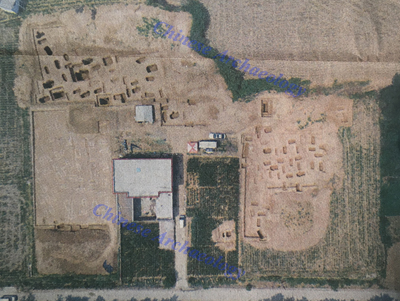
aerial view of the cemetery
The tombs were generally rectangular earthen shaft pit tombs, with the 2 meters in length and 1 meter in width. Most of them contained one or none inner coffins and few of them have both inner and outer coffins. The burial forms were recognizable, as three were prone burial and the rest were in extended supine position. There were over one hundred tombs with the head towards north or west, while few of them with the head towards east or south. A dozen tombs had waist pits buried with dogs.
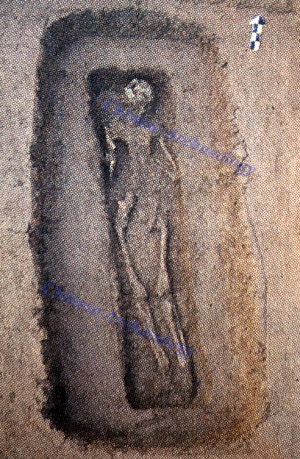
prone burial
Tomb M1 was the largest one, 3.8 meters east to west in length, 2.4 meters south to north in width and 3.8 meters in depth. M1 had been looted. M 17 was a chariot-buried pit,in which the wagon and the shaft were damaged, with only the rail, yoke and two wheels well preserved. The depth from the tomb entrance to the top of the wheels was 0.3 meters. The yoke was set beneath the east wall. A set of two rails was equipped with the yoke.
Five horse-buried pits were found, each in different depth and size. The entrances were generally 2.4 to 3 meters in length and 2 meters in width. The horse-buried pit MK4 has four horses and the others had two horses. The horse skeletons were piled in good order, since they might be buried after death. No chariot or harnesses was found. A bronze arrowhead was unearthed from MK4. It can be identified that some of these horse-buried pits had corresponding relations with the tombs.
chariot-buried pit
The burial objects can be categorized into potteries and bronze wares. Almost 200 pieces of potteries were found, mostly li vessels (ancient cooking tripod) and pots. There were also a few pottery bu vases and spindle whorls. Pottery li vessels were made of sandy grey clay and decorated with cord pattern, including short-foot with dish-mouth in Shang dynasty style, flared rim with flat crotch in Zhou dynasty style as well as a certain number of imitation bronze style and jia-shaped style (round tripot vessel with handle and capped column). There were three types of the pottery combinations: li vessel and pot, individual livessel, individual pot. The potteries, such as gui vessel (deep circular vessel with two or four handles) ordou vessel (food container), which were popular during Shang and Zhou Dynasties in northern Henan Province, were not found here. Generally, the combination of li vessel and pot was typical for the Zhou people during the end of the Shang Dynasty and beginning of the Zhou Dynasty, quite popular in the central Henan Province.
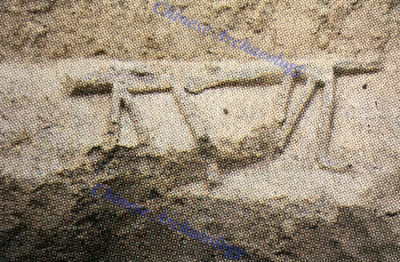
chariot equipment
The cemetery was seriously damaged with only one bronze ding tripod left. The ding tripod was in typical shape in early Western Zhou Dynasty. Other burial objects were weapons and chariot and harnesses, most were daggers and shields, and a few horse accessories (such as ornaments bridle Danglu, the endpiece of axile Wei, button-shaped buckle). Burial with damaged weapons was popular in these tombs. Bronze daggers and halberds were damaged to varying degrees. Pottery pots appeared rarely in the tombs with bronze daggers, which might be related to the gender or the profession of the tomb owner. Besides, there were also some seashells and jade ware found as well as few lacquer-ware and bronze fish.
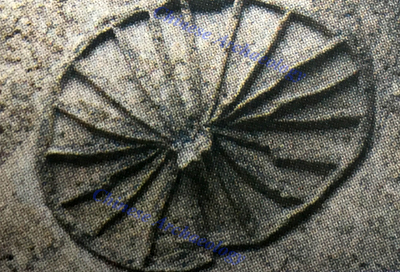
chariot wheel
Judging from the burial objects, the cemetery was dated from early phase of the early Western Zhou Dynasty till the middle part of the West Zhou Dynasty. The unearthed artifacts were similar to those from Xincun cemetery on north bank of Qihe River. The size of tombs was relatively small and the owners were mainly common people of medium and lower social class. It might be a strictly planned “state grave yard”. The tombs were different in sizes and burial objects. Some of them have horse-buried pits. There was also social class diversity; the direction of the heads, waist pit and other related burial custom revealed the diversity of the graveyard. Mostly tombs belonged to Zhou people, judging from the pottery combination ofli vessel and pot.
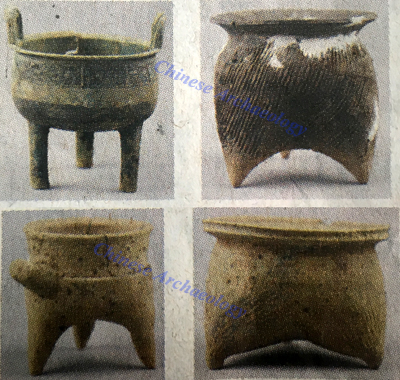
funerary objects
The excavation of the Wei State cemetery of the Western Zhou Dynasty in Yangjinzhuang bears major historic and academic significance. Influenced by pottery of the Shang Dynasty, the pottery at the end of the Shang Dynasty and beginning of the Zhou Dynasty in north Henan Province was controversial in its date. The finding of the Western Zhou cemetery in Yangjinzhuang was clear in time and the state it symbolized. Part of the potteries bore typical time and regional characteristics. Compared with pottery of the same time and region, they helped a lot in dating. It offered major clues for the survey and excavation of the Western Zhou Dynasty sites on both banks of Qi River centered on Xincun cemetery. Meanwhile, the earliest tombs can be dated to the early phase of the early Western Zhou Dynasty, which helped the academic field to understand the social and political pattern of the Western Zhou Dynasty on the former Shang land after “King Wu of Zhou overthrows tyrant Zhou of Shang (wuwangfazhou)”. (Translator: Yuan Yuan)

aerial view of the cemetery
The tombs were generally rectangular earthen shaft pit tombs, with the 2 meters in length and 1 meter in width. Most of them contained one or none inner coffins and few of them have both inner and outer coffins. The burial forms were recognizable, as three were prone burial and the rest were in extended supine position. There were over one hundred tombs with the head towards north or west, while few of them with the head towards east or south. A dozen tombs had waist pits buried with dogs.

prone burial
Tomb M1 was the largest one, 3.8 meters east to west in length, 2.4 meters south to north in width and 3.8 meters in depth. M1 had been looted. M 17 was a chariot-buried pit,in which the wagon and the shaft were damaged, with only the rail, yoke and two wheels well preserved. The depth from the tomb entrance to the top of the wheels was 0.3 meters. The yoke was set beneath the east wall. A set of two rails was equipped with the yoke.
Five horse-buried pits were found, each in different depth and size. The entrances were generally 2.4 to 3 meters in length and 2 meters in width. The horse-buried pit MK4 has four horses and the others had two horses. The horse skeletons were piled in good order, since they might be buried after death. No chariot or harnesses was found. A bronze arrowhead was unearthed from MK4. It can be identified that some of these horse-buried pits had corresponding relations with the tombs.

chariot-buried pit

chariot equipment
The cemetery was seriously damaged with only one bronze ding tripod left. The ding tripod was in typical shape in early Western Zhou Dynasty. Other burial objects were weapons and chariot and harnesses, most were daggers and shields, and a few horse accessories (such as ornaments bridle Danglu, the endpiece of axile Wei, button-shaped buckle). Burial with damaged weapons was popular in these tombs. Bronze daggers and halberds were damaged to varying degrees. Pottery pots appeared rarely in the tombs with bronze daggers, which might be related to the gender or the profession of the tomb owner. Besides, there were also some seashells and jade ware found as well as few lacquer-ware and bronze fish.

chariot wheel
Judging from the burial objects, the cemetery was dated from early phase of the early Western Zhou Dynasty till the middle part of the West Zhou Dynasty. The unearthed artifacts were similar to those from Xincun cemetery on north bank of Qihe River. The size of tombs was relatively small and the owners were mainly common people of medium and lower social class. It might be a strictly planned “state grave yard”. The tombs were different in sizes and burial objects. Some of them have horse-buried pits. There was also social class diversity; the direction of the heads, waist pit and other related burial custom revealed the diversity of the graveyard. Mostly tombs belonged to Zhou people, judging from the pottery combination ofli vessel and pot.

funerary objects
The excavation of the Wei State cemetery of the Western Zhou Dynasty in Yangjinzhuang bears major historic and academic significance. Influenced by pottery of the Shang Dynasty, the pottery at the end of the Shang Dynasty and beginning of the Zhou Dynasty in north Henan Province was controversial in its date. The finding of the Western Zhou cemetery in Yangjinzhuang was clear in time and the state it symbolized. Part of the potteries bore typical time and regional characteristics. Compared with pottery of the same time and region, they helped a lot in dating. It offered major clues for the survey and excavation of the Western Zhou Dynasty sites on both banks of Qi River centered on Xincun cemetery. Meanwhile, the earliest tombs can be dated to the early phase of the early Western Zhou Dynasty, which helped the academic field to understand the social and political pattern of the Western Zhou Dynasty on the former Shang land after “King Wu of Zhou overthrows tyrant Zhou of Shang (wuwangfazhou)”. (Translator: Yuan Yuan)
Category: English
News
Information
Key words:
